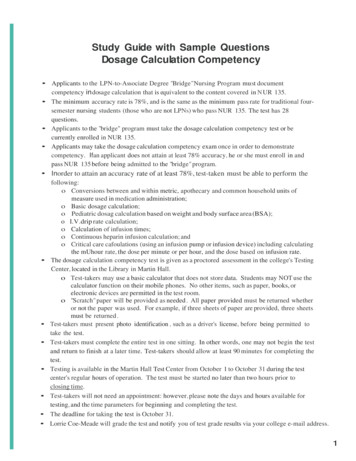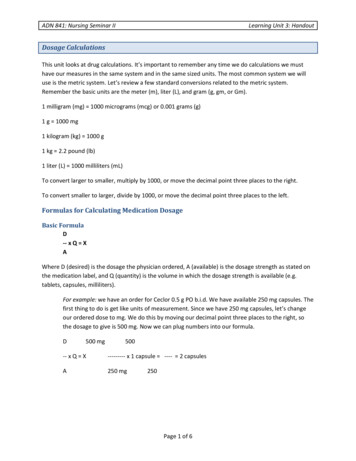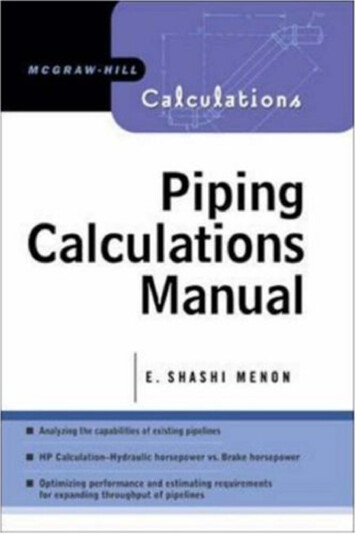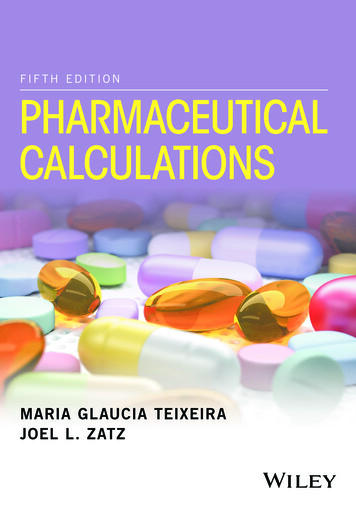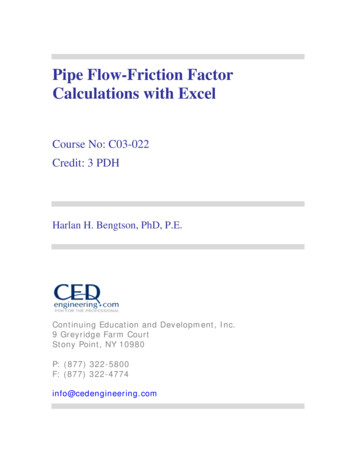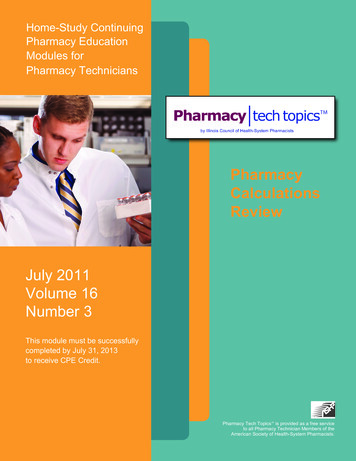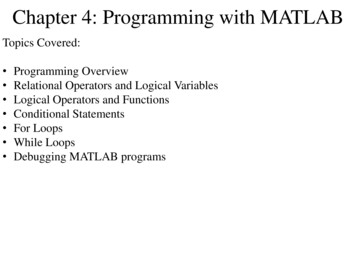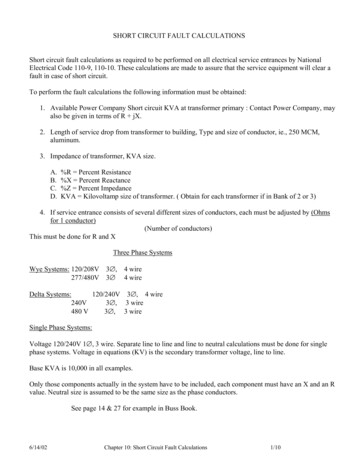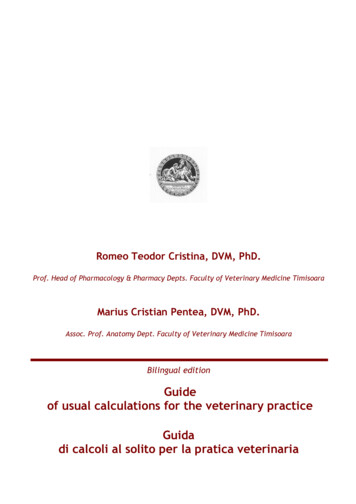
Transcription
Romeo Teodor Cristina, DVM, PhD.Prof. Head of Pharmacology & Pharmacy Depts. Faculty of Veterinary Medicine TimisoaraMarius Cristian Pentea, DVM, PhD.Assoc. Prof. Anatomy Dept. Faculty of Veterinary Medicine TimisoaraBilingual editionGuideof usual calculations for the veterinary practiceGuidadi calcoli al solito per la pratica veterinaria
Romeo T. CristinaMarius C. PenteaGuide of usual calculations for the veterinary practiceGuida dei calcoli al solito per uso veterinarioScientific reviewers Prof. Dr.H.C. Alexandra Trif, DVM, PhD., F.M.V. Timisoara Prof. Dr. H.C. Horia Cernescu, DVM, PhD., F.M.V. Timisoara 2010All rights resevedPrinted in RomaniaPiracy is theft and subject to criminal law!No part of this paper may be reproduced in any form or by any means mechanical orelectronic, or stored in a database without prior consent in writing of the first author.Concept & Editing:R.T. CristinaLayout text & Cover:R.T. Cristinawebsite: www.veterinarypharmacon.comTimisoara Brumar Publishing House is accredited by NURC(National Council of Research in Higher Education)website: CNCSIS: www.cncsis.roDescrierea CIPCRISTINA T. Romeo / PENTEA C. MariusGuide of usual calculations for the veterinary practiceGuida di calcoli al solito per la pratica veterinariaB R U M A R Timișoara, Romania, 2010ISBN: 978-973-602-563-12
Romeo T. CristinaMarius C. PenteaGuide of usual calculations for the veterinary practiceGuida dei calcoli al solito per uso veterinarioContentGuide of usual calculations forthe veterinary practice1. doses calculation2. concentration calculations3. medicinal formulas’ reduction or multiplication4. micro-quantities’s concentration5. calculation of drug concentrations in blood6. calculation of drug levels in the body7. anglo-saxon units & approved conversion factors8. expression and conversion of electrolites9. dosage extrapolation from human to the veterinary medicine10. calculation of drugs’ administration in drinking a di calcoli al solito per lapratica veterinaria1. il calcolo dele dosi2. calcolo delle concentrazioni3. la riduzione o la moltiplicazione di formulazione dei farmaci4. calcolo dela concentrazione dele microquantita5. calcolo delle concentrazioni dei farmaci nel sangue6. calcolo del medicinale nel organismo di animale7. unita di misura anglo - sassone (imperiali) e fattori di conversione8. la conversione della concentrazione dei elettroliti9. l’estrapolazione delle dosi dalla medicine umana alla veterinaria10. calcolo della somministrazione in acqua potabileBibliografia33841474850515557586268
Romeo T. CristinaMarius C. PenteaGuide of usual calculations for the veterinary practiceGuida dei calcoli al solito per uso veterinarioGuide of usual calculations forthe veterinary practiceIn his current activity in the prescription and administration of medicinesthe vet is obliged to apply often to usual calculations in veterinary medicine.By those calculations’ correctness it depend the success of therapy,being easy to understand what means the erroneous results applied intherapy.In this aim a remembering of the main therapy calculations is salutary.In this synthetic guide are presented: dosage calculations,concentrations’ and them transforming, recipes’ diminution and raising,calculation of drug microquantities in animals’ blood and body, electrolytes’conversion, the extrapolation of doses from human medicine in veterinarymedicine, calculation of drugs administered by drinking water.Key words: usual calculations, veterinary therapyAcknowledgmentsMany thanks to the student Samar Constantinescu for her consistenthelp in achieving this objective!4
Romeo T. CristinaMarius C. PenteaGuide of usual calculations for the veterinary practiceGuida dei calcoli al solito per uso veterinario1. DOSES CALCULATIONIn the current activity the amount of active substance it’s defined ingrams and in its subdivisions (centigrams and milligrams). Units bigger thanthe gram are not very frequently used, neither the ones that are smallerthan the milligram. The subdivisions of the gram are:1.00,10.010.0010.000001oneoneoneoneonegram (g)decigram (dg) 10 centigramscentigram (cg) 10 miligramsmiligram (mg)microgram (µg, mcg or gamma)The International System also defines the following as subdivisions of thegram as follows: nanogram 10-9 (ng), picogram 10-12 (pg), femtogram 10-15 (fg), attogram 10-18 (ag),Also in this context it is to remember about the logic correlation betweenfraction, decimal and percent, a trite operation but enough scrape forpracticians:FractionDecimalPercent 5871/2When we have to pass from grams to centigrams, decigrams or milligrams,the certain number will be 10 times, 100 or 1000 time the initial number.Example:3.0 grams 30dg, 300cg, 3.000mg, or0.07 grams 7cg, 70mgWhen we have to pass from decigrams, centigrams or miligrams to grams,the dose in grams will be 10, 100 or 1000 less than initial number.Example:4 decigrams 0.4 g;4 centigrams 0.04 g;4 miligrams 0.004 g.When calculating doses for prescribed medication for animals, it is knownthat these are prescribed by body weight, therfore we will multiply thedosage with the animal’s weight. After that we will calculate the necessaryamount of medication for the entire period of treatment, and raporting tothis we’ll make up the recipee.The basic rules when writting a recipee:5
Romeo T. CristinaMarius C. PenteaGuide of usual calculations for the veterinary practiceGuida dei calcoli al solito per uso veterinario pro dosis the dose for a single administration; pro die the dose for a day; pro cura the dose for the entire treatment.If the dose is not single, it will be multiplied with the number of dailyadministrations and with the period of treatment (usually, antibiotics areprescribed as pro dosis). If the dose is administrated once a day, it will bemultiplied with the number of days for the whole treatment and the resultwill be pro cura.Often in anesthesia, narcosis, infiltration or administration of the antidotpro dosis pro die pro cura, therfore there will be a single administration.Also to find out pro dosis and the dose pro die it will be devided by thenumber of administrations.Examples:1. For a 100 kg pig with Swine Erysipelas, the treatment will be withPenicilin G for 3 to 5 days (there were chosen 4 days for the treatment), thedose per body weight is 2000 UI/kg every 6 to 8 hours (there were chosen 6hours), and having at disposal bottles of Penicilin G of 400.000 U.I./ vial.Calculation:pro dosis:pro die:pro cura:2.000U.I. x 100 kg 200.000 U.I.;200.000U.I. x 4 adm. 800.000 U.I.;800.000 U.I. x 4 days 3.200.000 U.I.Rp./Penicilin G crist. flac. 400.000 UIN. VIIID.S. i.m. 4 x 200.000/day, for 4 days for a pig with Swine Erysipelas.Rp./Saline serum fi. of 10 mlN IVD.S. a vial / day for the dilution of Penicilin to a 100 kg pig2. For a 250 kg foal with digestive strongyloidosis, the treatment will bea powder of tiabendazol administered 440 mg/kgbw, for two days in a row.Calculation:pro dosis pro die : 0.44 x 250 kg 110 g/day;pro cura 110 x 2 days 220 g / a treatment.Rp./Tiabendazole pulv.220,0Div.p.aeq.N IID.S. int. an adm. a day for days in a row, for a foal with strongyloidosis.When administrating the doses of medication, we’ll have to take intoconsideration the species’ individual diferences which represent a biologicalvariation because of the farmacocinetical traits of reactivity andmetabolization, which are genetical determined.6
Romeo T. CristinaMarius C. PenteaGuide of usual calculations for the veterinary practiceGuida dei calcoli al solito per uso veterinarioThe specia, age, sex, health and wellness, the exploatation conditions areas many factors that only make the therapy look the same, it beeing diferentfrom an individual to another, and even from one season to onther.In order for the veterinary surgeon to succed he must take intoconsideration al of these, as well as the doses for each case in particular.Balaci was proposing, for easening the dosage calculation quantities,doses’ variations depending on specia, age and administration’s way. (seeTable 1.1.).Table 1.1.Dosage variation depending on the specia, age and way of administration(after Balaci, 1978)Dosage variation depending on the speciaBig ruminants (300 kg) 1-1½ the doseEquine (400 kg) 1 the doseMules (200 kg) 1/3–1/2 the doseSmall ruminants (50 kg) 1/6–1/5 the doseSwine (50 kg) 1/8–1/5 the doseDogs (20 kg) 1/16–1/10 the doseCats (2 kg) 1/32–1/20 the doseFowl 1/40–1/20 the doseDosage variations depending on the ageEquine 3-12 years 1 doseEquine 15-20 years 3/4 the doseEquine 20-25 years 1/2 the doseEquine 2 years 1/2 the doseFoal 1 year 1/2 the doseFoal 6-12 mounths 1/4 the doseBig ruminants 3-8 years 1 doseBig ruminants 10-15 years 3/4 the doseBig ruminants 15-20 years 1/2 the doseCalf 4-8 mounths 1/8 the doseCalf 1-4 mounts 1/16 the doseSheep and goats over 2 years 1 the doseSheep and goats 1-2 years 1/2 the dose6-12 mounths 1/4 the doseSwine over 1½ years 1 doseswine 9-18 mounths 1/2 the doseSwine 4-9 mounths 1/4 the doseDosage variations depending on the administration’s wayPer os (p.o.) 1 doseSubcutaneous (s.c.) 1/3 – 1/2 the doseIntravenous (i.v.) 1/3 – 1/4 the doseIntramuscular (i.m.) 1/2 – 1/3 the doseRectal (per rectum) 1 - 1½ the doseIntratracheal 1/4 the dose7
Romeo T. CristinaMarius C. PenteaGuide of usual calculations for the veterinary practiceGuida dei calcoli al solito per uso veterinario2. CONCENTRATION CALCULATIONSFarmaceutical items like: powders, ointments, pasta, solutions,suspensions, etc. are made of an active substance and the excipients.Their concentration can be expressed by: percent - %, ‰ or, parts.A 2‰ concentration means that in a 1000g of farmaceutical mixture (mlfor injectable solutions) there are 2 g of active substance, therefore in agram (one ml for injectable solutions) there are 0.002 g (mg) of activesubstance.2.1. Calculation of the active substance fromthe medicinal formThere are situations when, for medicational forms with a knownconcentration, need to be calculated the active substance contained.This type of calculation it is generally used for finding out the activesubstance from vials, bottles, powders, pastes, etc.Examples:1. From a 60 ml iodine aqueous solution of 0.045%, there must be findout the cuantity of iodine contained in the solution.Calculation:If in 100 ml solution there are . 0.045g Iodinethen in 60 ml solutin there are . x60 x 0.045x ---------------- 0.027 g.100so in 60 ml there are 0.027 g iodine.2. How much active substance it is in a vial of 20 ml of„Gentamicin a.u.v.” (it contains 8% gentamicine sulphate).Calculation:If in 100ml there are.8 g gentamicin sulfateThen in 20 ml there are. x20 x 8x ------------ 1.6 g.100So, in one bottle of 20 ml „Gentamicin” there are 1.6g gentamicinsulfate. (a.s.)8
Romeo T. CristinaMarius C. PenteaGuide of usual calculations for the veterinary practiceGuida dei calcoli al solito per uso veterinario3. How much active substance is in 120g of „Neomicin” 20% powderCalculation:If in 100g powder there are .20 g neomicin thenin 120 powder there are . x120 x 20x --------------- 24 g100So, in 120 g of „Neomicin” powder there are 24 g of base neomicin.2.2. Calculation of the necessary quantity of excipientto make a certain concentrationWhen the medication substance is administered in a solution afterfinding out the dose of the active substance there must be calculated thenecessary solvent in which wanted concentration can be disolved.Example:1. Prepare an aqueous solution of Nilverm (tetramisole chlorhydrate)12.5‰ for a 400 kg ox with dictyocaulosis, knowing that the efficientdose is 12.5 mg/kg.Calculation:I. First the necessary Nilverm for the animal’s treatment (prodosis):400 kg x 12.5 mg/kg 5.000 mg or 5.0 gII. The calculation of the necessary solvent for the dilution of 5 g ofNilverm, will be made like this:If 12.5g are in .1000ml solutionthen 5 g a.s. are in . . x5 x 1000x ———-----—— 400 ml sol. for administration12.502. What quantity of solution is necessary for the narcosis of a 5 kg catto which it will be administered i.v. the Glucoral narcotic in aaqueous solution 1% (0.036/kg).Calculation:The necessary pro dosis: 5 x 0.036 0.18 g narcotic/animal.I. The solvent necessary for the dilution of 0.18 Glucoral to a 1%solution:If 1.0 g is in .100 ml sol.Then 0.8g Glucoral is in .x0.18 x 100x -------------------- 18 ml sol. Glucoral1This solution is prepared ex tempore, in hot distilled water by addinguppon the 0.18 g. a.s. until the limit of 18 ml.9
Romeo T. CristinaMarius C. PenteaGuide of usual calculations for the veterinary practiceGuida dei calcoli al solito per uso veterinario2.3. Calculation of a farmaceutical product concentrationThis type of calculation is used when we want to find out theconcentration of some disinfectants or vermicid solutions, or injectablesolutions prepared ex-tempore.Examples:1. What concentration has an eterate solution of iodine (used inwound treatment) which in 800 ml has 40 g of active substance.Calculation:If 800 ml of solution contains .40g Iodinethen 100 ml solution contains . x100 x 40x --------------- 5 g of Iodine800So, the solution is of 5 %. It was made the division between the grams ofactive substance (a.s.) and the 100 ml and the result was the procentualconcentration. In the same way it can be obtained the ‰ concentration,dividing the grams with 1000 ml.2. What is the concentration of a „Cloramine B” solution (used inpavments disinfection) which in 2 l (2000 ml) contains 20 g ofCloramine a.s.Calculation:If 2.000 ml sol. contain . 20 g CloramineThen 100 ml sol. contain . x20 x 100x -------------- 1 g Cloramine2000So the solution is of 1% (or 10‰)2.4. Concentration conversionsOften in veterinary practice appears the need to convert a concentratedsolution in one with an inferior concentration. Also, we may want to obtainfrom two solutions with diffrent concentrations onther solution with a middleconcentration.2.4.1. The conversion of a high concentration solution intoa low concentration solutionThere can be two posibilities:1. When the initial cuantity of solution is known (with a high concentration).Examples: Convert a 800 ml solution of 30% into one of 4%Calculation: There are 2 ways of solving this:10
Romeo T. CristinaMarius C. PenteaGuide of usual calculations for the veterinary practiceGuida dei calcoli al solito per uso veterinarioa. It will be calculated on the basis of the active substance like this:If in 100ml there are . 30g a.s.Then in 800ml there are . x800 x 30x ------------------ 240 g a.s.100So we found out the cuantity of active substance present in the 800mlsolution of 30%. The cuantity of active substance will be converted into a 4%solution.If 4.0 g. a.s. are in .100 mlThen 240 g. a.s. are in . x240 x 100x ———-----—-- 6000 ml4In conclusion, to obtain a 4% solution will add 6000ml of water over the800 ml of 30% solution.b. The second way is faster and it basis on using the dilution factor:Higher concentrationFd ———---———-----------——-Lower concentration30In our case: Fd -—— 7.54The factor will be multiplied by initial quantity: 7.5 x 800 6000mlWe have found out that the 800 ml solution of 30% will be diluted untilthe wanted concentration, with 5200 ml of water:6000 - 800 5200 ml2. When the final cuantity is knownWe’ll take the last example again.Obtain a 7500 ml solution of 4%, form a 30% solution.Calculation:There are also two ways of solving this:a) Dilution factor:30Fd ------ 7.54In this case the final cuantity will be divided by the known quantity:7500x --------- 1000 ml sol. 30%7.5So, the 7500 ml solution of 4% will be obtained from diluting a 1000 mlconcentrated solution until 7500 ml.11
Romeo T. CristinaMarius C. PenteaGuide of usual calculations for the veterinary practiceGuida dei calcoli al solito per uso veterinariob) The second way is known as the rule of the arrows or rectangle:30%4 ml4%0%26 ml30 ml 4%, made of: 4 ml (30%) and 26 ml (0%)So, in the left part there are the initial concentrations (in the uppercorner is the higher concentration) which we’ll use to obtain the wantedconcentration (which we’ll write in the middle). From the subtraction of thesmaller numbers, on the diagonal will result the quantities with which theknown concentrations partcipate to the final concentration. From summingthe two obtained quantities we’ll have the quantity of solution of finalwanted concentration (in our example 30 ml of 4%).But taking into consideration that we need 7500 ml of 4% solution, we’llapply the next formula:If in 30ml sol. 4% there are . 4ml sol.30%Then in 7.500ml sol. 4% there are . x7.500 x 4x -------------- 1000 ml sol. 30%30By diluting a 1000 ml solution of 30% with 6500 ml of water we’ll obtain7500 ml of 4% solution.2.4.2. Obtaining a middle concentration from two diffrent onesIt doesn’t differ at all from the previous example, besides the smallerconcentration, which won’t be 0% (like the initial solvent).Example: Prepare 75 ml of glucose 30% from two solutions:one of 40% and one of 25%.Calculation:a. We’ll apply the rule of the arrows to obtain 15 ml of middle solutionof 30%.40%5 ml30%25%10 ml15 ml 30%made of: 5 ml (40%) and 10 ml (25%)b. If in 15 ml sol. 30% there are . 5 ml sol. 40%Then in 75 ml sol. 30% will be . x75 x 5x ———— 25 ml sol. 40%1512
Romeo T. CristinaMarius C. PenteaGuide of usual calculations for the veterinary practiceGuida dei calcoli al solito per uso veterinarioor:If in 15 ml sol. 30% there are . 10 ml sol. 25%Then in 75 ml sol. 30% will be . . x75 x 10x ----------- 50 ml sol. 25%152.5. Dilution depending on the densityThis type of calculation is rarely used in veterinary medicine and is madedepending on the densities. We either add pure disolvant or a dilutedsolution in the concentrated solution in the presence of a densimeter, eitherwith a calculation using the folowing formula:x q x d2 (d1 - d)d1 (d - d2)where:x disolvant quantity which needs to be added;q solution quantity that needs to be diluted;d density to which the solution will be diluted;d solution’s density which needs to be diluted;1d solution’s density with which is beeing diluted.2Example:Dilute 100 ml of concentrated acetic acid (96%) (with the desity of 1.050)to obtain a diluted solution of acetic acid (with a relative density of 1.037)to corespond with a 32% concentration.Calculation:(100 x 1 x (1.050-1.037)1.3x -------------------------------- --------- 33.3ml1.050 x (1.037-1)0.039There will be added 33.3 ml of distilated water to obtain the solutionwith the wanted density. In practice it is necesary that the diluated solutionsafter a calculation like this one, to be verified their denisties.In Table 2.1. there are written, for a better view, the substance quantitycontained in a ml of different concentration solutions.Table 2.1.The quantity of substance contained in 1 ml of different concentration solutions13Solution’sconcentrationThe quantity of active substance /1 .10100100010000100000
Romeo T. CristinaMarius C. PenteaGuide of usual calculations for the veterinary practiceGuida dei calcoli al solito per uso veterinario3. MEDICINAL FORMULAS’ REDUCTION OR MULTIPLICATIONIn practice often appears the need of a bigber quantity, or on thecontrary, of a smaller one, for a magistral product of which the formula isknown.This operation isn’t made to alter the proportions, but by respecting thismodification in a proportional way.Because of this we’ll apply the next:Wanted quantity x quantity of each componentThe proportional modification formula -------------Total quantity from the formulationExample:The magistral formula from below must be proportionaly after:a. risen from 40 g to 100 g orb. shrinken from 40 g to 20g (Table 3.1.).Solution:Table 3.1.The recipeeQuantityRisen with 100 gfrom theCalculation:Quantity :Recipee:Calculation:100 x 140100 x 240100 x 540100 x 940100 x 404020 x 14020 x 24020 x 54020 x 94020 x 4040Shirnken with 20 gQuanity:Rp./IchtiolSulfathiasole pulv.1,02,0Tanophorm5,0Zinc oxide9,0Axungia40,0M.f. ung. (Misce fiat unguentum)D.S. Ext. to a horse with a chain burn142,55,012,522,5100,00,51,02,54,520,0
Romeo T. CristinaMarius C. PenteaGuide of usual calculations for the veterinary practiceGuida dei calcoli al solito per uso veterinario4. MICRO-QUANTITIES’S CONCENTRATIONThere are situations (especially in the case of adminstering mineralpremixes, vitamins, growth factors, antibiotics, hormons, etc.), when itappears the need to calculate small, insignifiant, quantities of activesubstance within a big, often huge mass, as an excipient (feed powders,drinkable solutions). More often these quantities are expressed in: ppm ppb ppt(parts per million)(parts per billion)(parts per trillion)4.1. Part(s) per million (ppm)One part of active substance homogenized in 999.999 parts of excipientmass. And if we go to the metric system:1 mg1 ppm --------------- or1000.000 mg1 mg1 mg1 ppm ------- or 1 ppm ---------- or1 kg1000 g1 mcg1 ppm ---------1gIn Table no. 4.1. is given the correlation between the ppm andconcentration.Table 4.1.0.0000001 0.001 1 ppb0.01 10 ppb10.00010.1 100 1.0The corelation ppm / concentrationIn the experimental pharmacology or toxicology there are also known thefollowings:4.2. Part(s) per billion (ppb)Represents the expression of a part of active substance to 1.000.000.000(actually 999.999.999 parts of excipients).Therefore: 1 ppb 1 mcg./1.000.000.000 mg. or, 1 ppb 1 mcg./1.000.000 mg. ie, 1 ppb 1 mcg./1000 g (1 mcg./1 kg).15
Romeo T. CristinaMarius C. PenteaGuide of usual calculations for the veterinary practiceGuida dei calcoli al solito per uso veterinario4.3. Part(s) per trillion (ppt) or parts per trilionIt is used rarely and it represent one part of active substance (usually forpotentially toxic substances: alkaloids, poisons from fungae, insects,reptiles, etc.) to 1.000.000.000.000 (999.999.999.999) parts of excipients,and the final formula will be 1ppt 1mcg / 100 kg.The corelation between ppm and concentration (%) will be determinedthis way:1ppm 1 mg / kg or 1 mg / 1.000.000 mg.In the opposite way the conversion to percent is made by multipling with100.And so: 0,000001 x 100 0,0001%, i.e. that1ppm corresponds to the concentration of 0,0001%.Example:a) How much, exprimed in grams, are 200 ppm of biostimulator per a tonof chicken feed.1 ppm 1 mg / 1 kg furaj, so for a ton of feed there will benecessary 200 x 1.000 mg / 1000 kg 200 g/1 ton feed.b) Prepare 3 tones of compound feed for piglets which will contain400 ppm of arsanilic acid.1 ppm 1 mg / 1 kg or 1 g /tone, the rule of threes will be used.100 ppm 100 g / ton400 ppm x g / ton400 x 100x ------------ 400g / ton x 3 1200g100i.e.: 1.2 kg of arsanilic acid for 3 tones of feed.16
Romeo T. CristinaMarius C. PenteaGuide of usual calculations for the veterinary practiceGuida dei calcoli al solito per uso veterinario5. CALCULATION OF DRUG CONCENTRATIONS IN BLOODThe amount of medicine in the blood or other body fluids of animals areprecious indicators for the exploitation of the products of animal origin (inlight of new regulations, more stringent in this regard).Most often expressions of residues in the European Community are inppm, but there are countries where these expressions are still made in: mg/100ml;mg/100 ml;mg%;mg/liter,milliequivalentsFor this reason, up to global consistency, we play a few conversioncalculations.Examples:a) Convert blood value of 0.9 ppm in mg / 100 ml.It will start from the fact that:0.9 ppm 0.09 mg /100ml or 90 mcg / 100ml.So 0.9 ppm 0.09 mg / 100 ml or 90mcg / 100ml.b) Convert blood value of 0.9 ppm in mcg / ml.0.9 ppm 0.09 mg / 100 ml and 1 mg / 1 000 mcgSo 0.09 mg/100 ml 90 mcg / 100 ml or 0.9 mcg / ml.c) Convert blood value of 0.9 ppm in mg%. 1mg% 1 mg / 100 ml0,9ppm 0,09mg/100ml or 0,09 mg%Knowing that the specific gravity of animals’ blood is between very largelimits, depending on the species (from 1.039 to 1.061), for ease ofcalculation it was chosen the value of: 1.0017
Romeo T. CristinaMarius C. PenteaGuide of usual calculations for the veterinary practiceGuida dei calcoli al solito per uso veterinario6. CALCULATION OF DRUG LEVELS IN THE BODYIn the administration of medicated feed, the rate of exposure to thesedrugs can be dangerous if it is above the permissible limits (and restrictiveprovisions in this area are severe).The accepted formula ppm of feed conversion in mg drug/kg.bodyweight.(feed ppm rate) x (kg feed consumed/day)mg s.a./kgc -----animal weightNote: The value of feed consumed daily is taken from the consumption tabel.Example:Calculate the rate of distribution per kg body weight of a drug (M)administered in feed to 20 pigs with an average weight of 10 kg at a dose of20 ppm.So: 20 ppm 20 mg / kg feed.Appling the formula:20 mg/kg x 0.6 kg/day12 mg--------------------------------- --------- 1.2 mg/kg10 kg10 kgConversely, the calculation of a drug in ppm can be redone, expressed asmg/kg in the following formula:mg/kgppm --------------------procentage (%) of body weight of feed consumed per dayStarting from the above example, where it was established that a 10 kgpig consumes daily a 6% of its body weight, our relationship will become:1.2 mg/kg6/100 0.06, that is: --------------- 20 ppm0.06This type of calculation is particularly useful when there are suspicionsof exceeding the limits of feed additives incorporated into the medicatedfeed that could be followed by lower feed consumption rate, anorexia, oreven poisoning.In Tables 6.1. and 6.2. are shown the consumption rates of feed andwater for domestic animal species.18
Romeo T. CristinaMarius C. PenteaGuide of usual calculations for the veterinary practiceGuida dei calcoli al solito per uso veterinarioThe estimation of water amount in the body can be accurately madeusing: the method of heavy water (D2O) or tritiated water (HTO).Water depletionThe water loss during 24 hours, usually sways water intake, there beeinga symmetry between intake and elimination.Water has an exogenous and also an endogenous origin.In addition to drinking water and feed constitution water, endogenouswater is the result of catabolic processes nutrients.Organic compounds with a high content of hydrogen will produce higherquantities of water.For example, by oxidation of: 100 g lipids produce 119 g water; 100 g carbohydrates produce 56 g water, 100 g protein, 46 g water.Exogenous water requirement is very different in terms of: specia, physiological state, age etc.19
Romeo T. CristinaMarius C. PenteaGuide of usual calculations for the veterinary practiceGuida dei calcoli al solito per uso veterinarioTable 6.1.Feed consumption rates by animal species, in ideal conditions(after NRC – Nutrient Requirement Data)CategorySpeciaEquinesDonkeysLight breed mulesHeavy breed mulesFattening cattle onstagesDairy cowsSwine onfattening stagesRams on fatteningstagesSheepDogs (dry food)Adult dogsPoultry20YouthLight breedsMiddle breedsHeavy ltsIIIIIIFinisherNon–pregnant lactatingGestations’ last 2 monthsIIIIIIIVVFinisherIFinisherNon-pregnant (lactating)PregnantGrowingCategoriesBefore layingDuring laying4 weeks chicken8 weeks chicken12 weeks chickenDaily consumedfeed (% from thekgpoundsBody .1350-800 770-17601.4 – 1.2350-800 770-17601.8 - 6.72.505,55.0Body weight
Romeo T. CristinaMarius C. PenteaGuide of usual calculations for the veterinary practiceGuida dei calcoli al solito per uso veterinarioTable 6.2.Water consumption rates in domestic animal speciesSpeciaEquineCattleSwineSheepChikens(after NRC – Nutrient Requirement Data)CategoryDaily water consumption/headLactating mares4.0 l / liter of milkEquine5.4 l / 100 kgc.Fattening adults38 - 45 l or 3 - 8 l/kg dry feedFattening youth after weaning15-23 lFinisher fattening youth30-38 lDairy cows45-136 l or 3-4 l water / liter of milk4-8 weeks calves3.8 – 5.6 l12-20 weeks calves7.6-17 l6 months calves15.0 lPregnant sows13 - 17 lLactating sows19 - 23 l5-15 kg piglets2.3 – 3.8 l15-30 kg piglets3.0 l30-50 kg piglets7.6 l75-90 kg piglets5.7 - 13.0 lLambs3.0 lPregnant sheep3.8 lLactating sheep5.7 lBefore laying19 l / 100 chickensDuring laying19 - 28 l / 100 chikens4 weeks chicken7.6 l / 100 chicken8 weeks chicken15.5 l / 100 chiken12 weeks chicken21 l / 100 chikenWith ontogenesis, the amount of water decreases as follows: Embryo- 95% of the body weight. Foetus- 86 % of the body weight New borned - 75% of the body weightThe water content decreasing rapidley, during development andmaturati
Romeo Teodor Cristina, DVM, PhD. Prof. Head of Pharmacology & Pharmacy Depts. Faculty of Veterinary Medicine Timisoara Marius Cristian Pentea, DVM, PhD.




